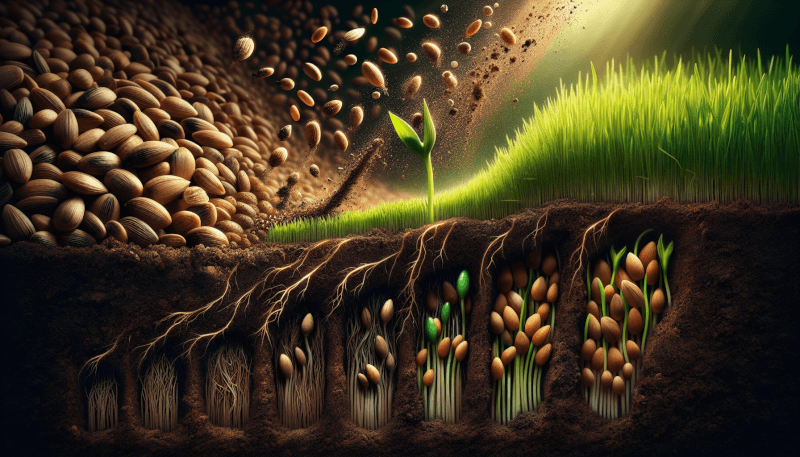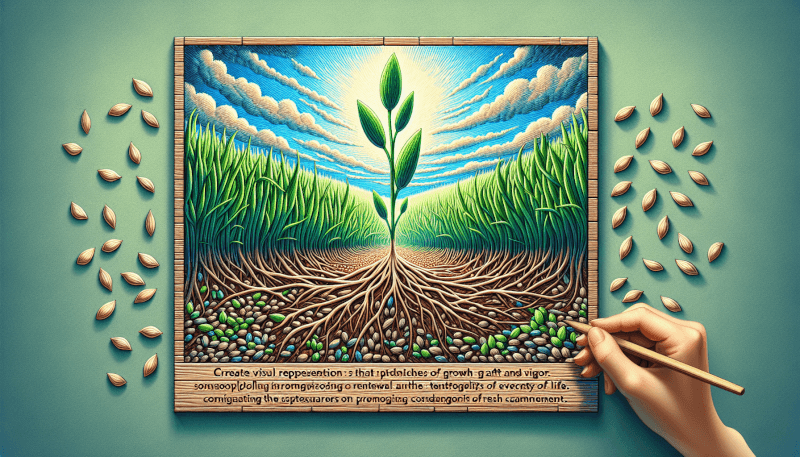👋 Click the mic button to talk to Alfred, the Todd's Seeds Gardening/Sprouting Expert – Feel free to ask him anything!
Ask Virtual Todd Anything - Click the Mic
Imagine transforming your backyard into a lush, vibrant oasis with a carpet of green grass, just by growing seeds. The process of growing seeds grass may seem daunting at first, but with a little patience and know-how, you can easily achieve beautiful, healthy turf that will be the envy of your neighborhood. In this article, we will explore the step-by-step process of growing seeds grass, providing you with valuable tips and tricks along the way. Get ready to turn your dull patch of soil into a thriving green paradise!

Preparing the Soil
Clearing the area
Before starting the process of growing grass from seeds, it is important to clear the area of any debris, rocks, or existing vegetation. This will provide a clean and fresh canvas for your new lawn to thrive.
Loosening the soil
Once the area is clear, the next step is to loosen the soil. Use a garden fork or a tiller to break up compacted soil and improve drainage. Loosening the soil will also help the grass roots penetrate easily and promote healthy growth.
Removing weeds and rocks
Weeds can compete with grass for nutrients and water, so it is crucial to eliminate any existing weeds. Use a weed remover tool or manually pull them out, ensuring you remove the roots as well. Additionally, removing rocks is vital to create a level surface and prevent any obstacles that may hinder the growth of your grass.
Leveling the ground
To achieve a smooth and even lawn, it is important to level the ground. Use a rake or a leveling tool to fill in any low spots and remove excess soil from high spots. A level surface will help in the proper distribution of water and nutrients, ensuring uniform growth of the grass.
Choosing the Right Seed
Consider the climate
When choosing grass seeds, it is essential to consider the climate of your region. Different grass types thrive in different climates, so select seeds that are suitable for your local climate conditions. Whether you live in a warm or cool climate, ensure the grass species you choose can withstand the temperature extremes in your area.
Identify the grass type
Identifying the type of grass that best suits your needs is crucial for a successful lawn. Consider factors such as the desired appearance, tolerance to foot traffic, and maintenance requirements. Common grass types include Kentucky Bluegrass, Bermuda Grass, and Tall Fescue. Research each type and choose the one that aligns with your preferences and the conditions of your yard.
Select the right seed mixture
In some cases, a single grass type may not fulfill all your lawn requirements. Consider selecting a seed mixture that combines different grass varieties to create a more resilient and versatile lawn. Mixtures can include a combination of cool-season and warm-season grasses, providing a lush and green lawn throughout the year.
Check for quality
When purchasing grass seeds, always check for quality. Look for seeds that are clean, free from contaminants, and have high germination rates. High-quality seeds will give you the best chance of achieving a healthy and vibrant lawn. Read customer reviews or seek advice from professionals to ensure you are selecting the right seed variety for your specific needs.
Testing the Soil
Understanding soil pH
Testing the pH level of your soil is crucial for the optimal growth of your grass. Most grasses prefer a slightly acidic soil with a pH range of 6.0 to 7.0. Testing kits are available at gardening centers or you can get your soil tested professionally. If the pH level is not within the desired range, make necessary amendments to adjust the acidity or alkalinity accordingly.
Testing for nutrient levels
A soil test is also essential to determine the nutrient levels in your soil. It will help you understand which nutrients are lacking or in excess, allowing you to make informed decisions about fertilization. Soil test kits or professional soil tests can provide accurate information about the nutrient content of your soil, enabling you to provide the necessary supplements for healthy grass growth.
Improving the soil if necessary
Based on the results of the soil test, you may need to improve the quality of your soil. If the soil lacks essential nutrients, consider adding organic matter such as compost or well-rotted manure to enrich it. This will provide a fertile environment for the grass to thrive. Additionally, correcting any nutrient imbalances or deficiencies will ensure optimal growth and a vibrant, green lawn.
Sowing the Seeds
Determining the ideal time
Timing is crucial when sowing grass seeds. The ideal time to sow grass seeds depends on the type of grass and the climate of your region. Cool-season grasses should be sown in early spring or early fall when temperatures are cooler. Warm-season grasses should be sown during late spring or early summer when soil temperatures are warmer. Follow the recommended sowing time for the specific grass type you have chosen to maximize germination and establishment.
Calculating the seed quantity
Determining the right amount of grass seed is important to achieve the desired thickness without overcrowding or wasting seeds. Most grass seed packages provide instructions on the recommended seeding rates. Measure the area to be seeded and calculate the quantity of grass seeds accordingly. Proper seed density will lead to healthy and uniform growth, avoiding any patchy areas in your lawn.
Applying the seeds evenly
To ensure uniform growth, it is crucial to distribute the grass seeds evenly across the prepared soil. One effective technique is to divide the seed quantity into equal portions and sow them in parallel rows. It is also helpful to use a seed spreader for an even distribution. Applying the seeds evenly will promote consistent germination and result in a lush and beautiful lawn.
Using proper seed distribution techniques
Proper seed distribution techniques are essential for successful grass growth. One popular technique is overseeding, which involves spreading the seeds over an existing lawn to improve its density and fill in bare areas. Another technique is hydroseeding, which involves mixing the seeds with a slurry and spraying it onto the soil. Choose the technique that suits your needs and follow the recommended practices to ensure optimal seed distribution.

Watering and Fertilizing
Establishing a watering routine
Watering plays a crucial role in grass seed germination and establishment. After sowing the seeds, it is important to establish a regular watering routine. Keep the top inch of soil consistently moist, but avoid overwatering, as it can lead to diseases and shallow root growth. Water the newly seeded area lightly multiple times a day to ensure the seeds stay hydrated and promote germination.
Providing adequate moisture
As the grass seeds germinate, gradually reduce the frequency of watering while increasing the amount of water applied. This will encourage the grass roots to grow deeper into the soil in search of moisture and build a strong foundation. Monitor the soil moisture level regularly and adjust your watering routine according to the needs of your specific grass type and the prevailing weather conditions.
Choosing the right type of fertilizer
Fertilizers provide essential nutrients to support healthy grass growth. Selecting the right type of fertilizer depends on the grass species and the specific nutrient requirements identified through soil testing. Find a balanced fertilizer that provides a combination of nitrogen, phosphorus, and potassium, along with other secondary nutrients, to support strong root development and overall lawn health.
Applying fertilizer at the correct time
Timing is crucial when it comes to fertilizing your lawn. Apply fertilizer according to the recommended schedule for your grass type. As a general guideline, apply a slow-release fertilizer in early spring to encourage steady growth, followed by additional applications during the growing season. Avoid fertilizing during periods of drought or extreme heat, as this can stress the grass and lead to burnout.
Protecting the Seeds
Covering the area with straw or mulch
Covering the newly sown area with straw or mulch can provide several benefits. It helps retain moisture in the soil and provides protection from extreme temperatures. Additionally, straw or mulch acts as a barrier against bird feeding and helps prevent erosion. Distribute a thin layer of straw or mulch over the newly seeded area, ensuring it does not smother the seeds but provides adequate coverage.
Using protective netting
Birds can be a common nuisance when it comes to grass seeds. They may feed on the newly sown seeds, impacting germination and seed establishment. Use protective netting or bird deterrent devices to keep birds away from the seeded area. Secure the netting properly to prevent any entanglements and ensure it does not disrupt the growth or impede the access of water and sunlight.
Preventing bird damage
In addition to using netting, other measures can help prevent bird damage. Some gardeners hang reflective objects, such as aluminum foil strips or old CDs, near the seeded area to deter birds. Playing recorded predator sounds or installing fake predators like owl statues can also help in bird control. Explore different bird deterrent methods and choose the ones that are effective and safe for your grass seedlings.
Guarding against foot traffic
Foot traffic can easily damage freshly sown grass seeds, leading to uneven growth and bare patches. Encourage family members, guests, and pets to stay off the seeded area until the grass is well-established. Place temporary barriers or signs to remind people about the ongoing grass establishment process. By guarding against foot traffic, you allow the grass seeds to germinate undisturbed, ensuring a more uniform and lush lawn.

Maintaining Proper Care
Regularly mowing the grass
Once the grass has reached a height of about 2-3 inches, it is time to start mowing. Set your mower to the recommended height for your specific grass type, ensuring you do not remove more than one-third of the grass blade at a time. Regular mowing helps promote healthy growth, prevents weed infestation, and gives your lawn a neat and uniform appearance.
Removing weeds
Even with proper soil preparation and seed selection, some weeds may still find their way into your lawn. Removing weeds promptly is essential to prevent them from spreading and outcompeting the grass. Use a handheld weeder or a hoe to remove weeds manually, ensuring you remove the entire root system. Regular weeding will keep your lawn free from unsightly invaders and promote the growth of a healthy and weed-free grass.
Applying weed control products
If weed infestation becomes problematic, you may need to consider using weed control products. Select herbicides that are specifically labeled for your grass type and the types of weeds you want to control. Follow the instructions carefully and apply the herbicide at the recommended time and rate. It is important to note that some herbicides can harm young grass, so make sure to apply them only after the newly established grass has matured.
Aerating the soil
Over time, the soil beneath your lawn may become compacted, which can hinder root growth and nutrient absorption. Aerating the soil is a process that helps alleviate compaction and improve the overall health of your grass. Use a core aerator or a spike aerator to create small holes in the soil, allowing air, water, and nutrients to penetrate deeper into the root zone. Aerate your lawn annually or as needed to keep the soil in optimal condition.
Dealing with Common Issues
Addressing diseases and pests
Diseases and pests can pose significant challenges to the health and appearance of your lawn. Keep a close eye on your grass for any signs of disease or pest infestation, such as discoloration, thinning, or irregular growth patterns. Consult a professional or refer to reputable gardening resources to accurately diagnose the problem and identify appropriate treatment methods.
Identifying and treating fungal infections
Fungal infections are common lawn problems that can cause brown patches, thinning, and discolored areas. Proper lawn care practices, such as avoiding overwatering and ensuring proper drainage, can help prevent fungal infections. If an infection does occur, fungicides may be necessary to control and eliminate the fungus. Choose fungicides that are labeled for the specific type of fungus affecting your lawn and apply them according to the instructions.
Managing excessive thatch buildup
Thatch is the layer of organic debris that accumulates between the grass blades and soil surface. While a thin layer of thatch can be beneficial, excessive thatch buildup can prevent water, nutrients, and air from reaching the roots. Regular maintenance practices such as proper mowing height, regular aeration, and dethatching can help manage thatch buildup. Utilize a dethatching machine or a specially designed rake to remove excess thatch and maintain a healthy lawn.
Handling dry patches
Dry patches in your lawn can occur due to uneven watering or poor irrigation coverage. These areas can become unsightly and lead to sparse growth. To address dry patches, ensure that your watering routine is consistent and that all areas of your lawn receive adequate moisture. Adjust irrigation systems as needed to ensure even coverage. If the dry patches persist, consider testing the soil in those areas for any underlying issues that may need to be addressed.

Monitoring Growth Progress
Observing germination
After sowing the grass seeds, it is important to monitor the germination process. Germination typically occurs within 7 to 21 days, depending on the grass type and environmental conditions. Regularly inspect the seeded area and look for signs of seedlings emerging from the soil. This will give you an indication of how well your grass seeds are germinating and help you adjust your care routine accordingly.
Tracking growth rate
As the grass starts to grow, track the growth rate to ensure that it is progressing as expected. Measure the height of the grass periodically and compare it to the recommended growth rates for your specific grass type. If the growth rate seems slower or faster than expected, adjust your maintenance practices accordingly. Monitoring the growth rate allows you to identify any potential issues early on and take corrective measures.
Evaluating the overall health
A healthy lawn is characterized by its vibrant green color, uniform growth, and absence of disease or weed infestation. Regularly evaluate the overall health of your lawn by visually inspecting the grass, checking for any signs of stress, discoloration, or irregular growth. Address any issues promptly to maintain the health and beauty of your lawn. Healthy grass not only enhances the aesthetics of your outdoor space but also provides a comfortable and inviting environment.
Adjusting care based on progress
Based on your observations and evaluations, adjust your lawn care routine to meet the specific needs of your grass. If the grass is growing too fast, consider adjusting the mowing frequency or raising the mower height. If the grass appears stressed or lacks vigor, review your watering and fertilizing practices to ensure they are adequate. By continuously monitoring and adjusting your care routine, you can ensure that your grass continues to thrive and maintain its lush appearance.
Achieving a Lush Lawn
Promoting thickness with overseeding
Over time, existing lawns may develop thin or bare patches due to foot traffic, diseases, or other factors. Overseeding is a technique used to introduce new grass seeds into an existing lawn to restore thickness and fill in bare areas. Choose a grass seed blend that matches the existing lawn and follow the recommended overseeding practices. This process will help rejuvenate the lawn and promote a denser, more resilient turf.
Creating uniformity with dethatching
Dethatching is a process that removes the layer of thatch from the lawn, allowing the grass to grow more uniformly. As thatch accumulates, it can create uneven growth and hinder the penetration of water, air, and nutrients. Use a dethatching machine or a specially designed rake to remove the excess thatch, promoting healthier growth, and ensuring a more uniform appearance throughout the lawn.
Optimizing grass color with fertilizer
Fertilizers not only provide essential nutrients, but they can also enhance the color of your grass. Applying fertilizers with a balanced nutrient profile, including nitrogen, can promote vibrant, green growth. However, it is important to follow the recommended fertilization schedule to avoid overfertilization, which can lead to excessive growth and potential health problems. Achieving the optimal grass color requires a well-balanced approach to fertilization, ensuring that the grass receives the nutrients it needs without becoming overly lush or prone to diseases.
Developing a regular maintenance routine
Consistency is key when it comes to maintaining a lush lawn. Develop a regular maintenance routine that includes mowing, watering, fertilizing, and other necessary tasks. This routine will help you stay on top of lawn care tasks, ensuring that your grass gets the attention it needs to thrive. Remember to adapt your routine based on the specific needs of your grass, as different varieties may require slightly different care practices.
Growing seeds grass is a fulfilling and rewarding process that allows you to create a lush and vibrant lawn. By following the steps outlined in this article, from preparing the soil to maintaining proper care, you can ensure the successful growth of your grass seeds. Remember to consider factors such as climate, grass type, and soil condition when making decisions throughout the process. With consistent care and attention, your lawn will flourish, providing you with a beautiful outdoor space to enjoy for years to come.
